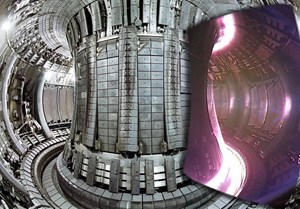Just to round off this blog I want to leave you with a couple of really awesome things;
Firstly, to show the progress technology can make to secure our future:
In 2013 a collaborative effort by the EU, India, Japan, Russia, South Korea, the People's Republic of China, and the US, began constructing the ITER in southern France. It has cost £13bn ($16bn) so far, almost half of which paid by the EU, and due to begin testing in 2020. Operation costs are believed to exceed 30 times the value thus far. But once running will produce 500 megawatts of energy from 50 megawatts to operate.
The ancient gas clouds
pulled together by gravity over billions of years formed perfect conditions for
fusion: enormous stellar-engines known as stars (suns). Fusion reactions reach
in excess of 15,000,000oC at a stars core, the light and warmth we
feel from our sun is the energy given off by the collision of hydrogen nuclei
fusing into heavier helium atoms.
The ITER (International Thermonuclear Experimental Reactor) is just the sort of techno-optimist, grand-scale nuclear engineering project Bob (Robert Zubrin: Case for Mars) might get excited about, as this is something based on science fiction (not too dissimilar to Iron Man's "Arc Reactor": harnessing the power of the sun. This is the world's largest Tokamak, and is in fact, a fusion reactor (fuses hydrogen nuclear to make helium), and is far safer than fission reactors (far more volatile reaction that can be dangerous when out of control - Chrnobyl).
"There is no possibility of a catastrophic
accident in a fusion reactor resulting in major release of radioactivity to the
environment or injury to non-staff, unlike modern fission reactors… If the
reactor suffered damage or lost even a small degree of required control, fusion
reactions and heat generation would rapidly cease" ~ Krista Dulon
It uses deuterium (Mr Zubrin pay attention if you would) and tritium (two isotopes of hydrogen) as fuel, heated to 150m degrees celsius plus, and the plasma formed is contained inside a strong magnetic field. Waste management is far safer and easier than fission-waste: half-life is generally smaller than fission, losing radioactivity on a timescale manageable with current engineering (safe, long-term storage). The only health-risk would be the minute release of tritium, which is a fraction of the potency of fission-releases, and cycles out of the body instead of bioaccumulating (build up in organisms).
Three, two, one ... We have plasma!
Inside the European JET Tokamak, both before and during operation. Photo: EFDA,
JET.
On top of being severely cool, this machine and fusion-science hold enormous potential to resolve the energy crisis, "perhaps" indefinitely; but does not mean we should abandon the necessary socio-political and economic changes to be made in the now to conserve what remains, and nurture our planet, and not fall into techno-dependency. Finally, the most detailed (and also beautiful) image ever taken (1.5 Gigapixel - 1.5 billion pixels; 600 HD screens), photographing 100 million stars of the Andromeda Galaxy [NASA].


No comments:
Post a Comment